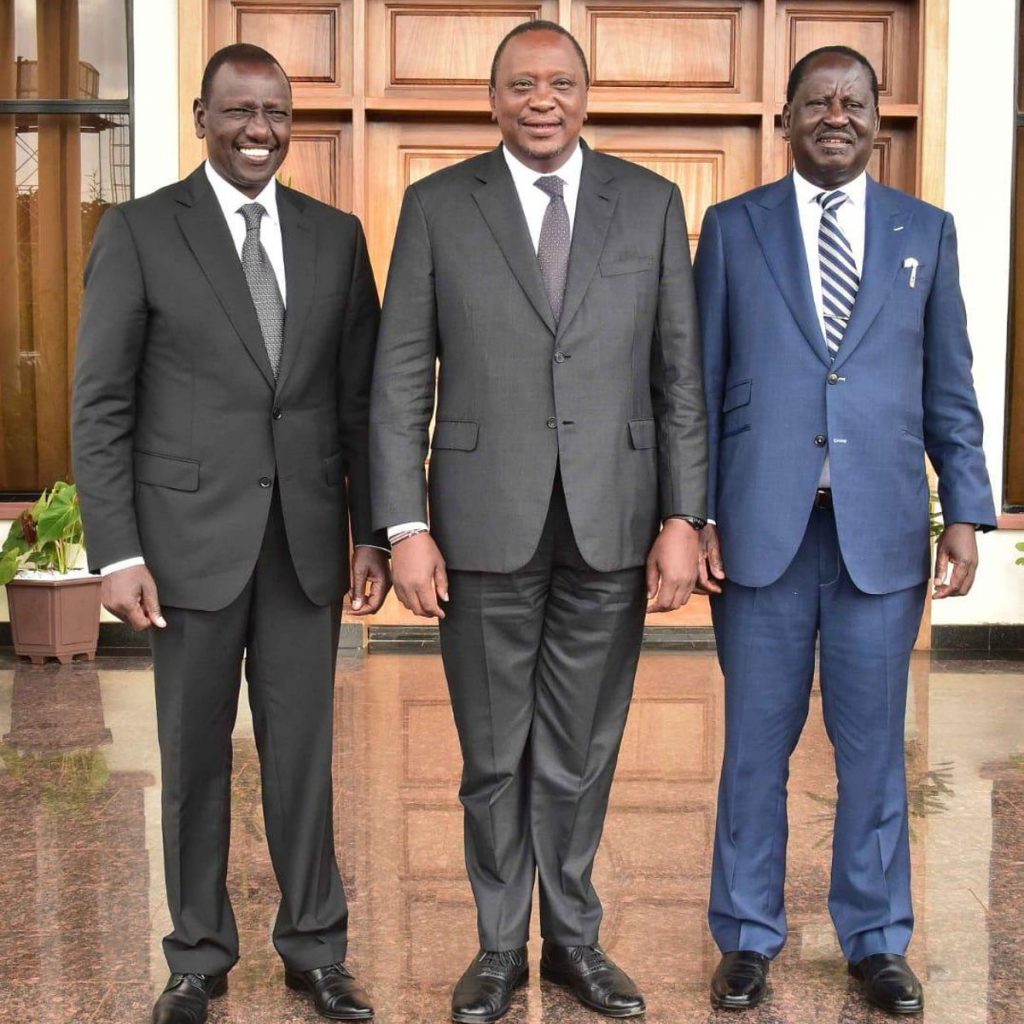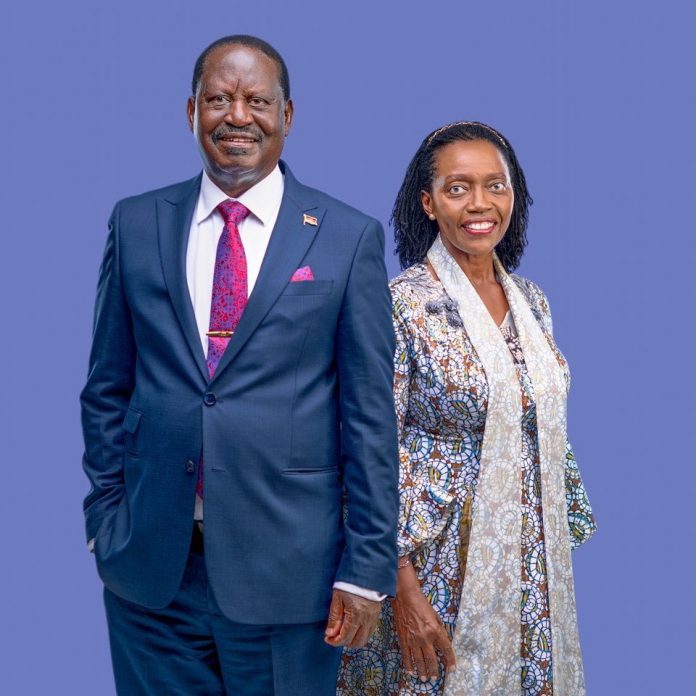NAIROBI
BY KWENDO OPANGA
Her initial five barnstorming campaigns through Mount Kenya, have shown Kenyans that the fighting spirit she showed in 2007 as President Mwai Kibaki’s campaign agent, was a tip of an iceberg. Her petite physique packs a tiger's energy, power and fierceness. And, she pounces on attackers and hecklers with rapid and rattling verbal fire.
What is the next General Election about? This question should not arise because the answer should be obvious. The August General Election should be a referendum on the performance of the outgoing Jubilee Party-run government.
The issue should be whether the lives of Kenyans are better now than they were in 2013 when President Kenyatta and Deputy President William Ruto took power. That in turn means the driver of this electioneering should be the economy and pocketbook issues of families or, put another way, the ability of Kenyans to make ends meet. But, things are not that clearcut. Why?

RAILA ODINGA AND MARTHA KARUAFirstly, the entry of Ms Martha Karua into the presidential race as running mate of Mr Raila Odinga, has been a political earthquake. Its tremors are still being felt a fortnight after her presentation and it has turned Kenya’s politics on its head.
Her initial five barnstorming campaigns through Mount Kenya, have shown Kenyans that the fighting spirit she showed in 2007 as President Mwai Kibaki’s campaign agent, was a tip of an iceberg. Her petite physique packs a tiger’s energy, power and fierceness. And, she pounces on attackers and hecklers with rapid and rattling verbal fire.
Crucially, her emergence as potential Deputy President and therefore a heartbeat away from the ultimate seat of power, has not only focused attention on August 9, but also on August of 2027.
Odinga is expected to serve one term and lay the foundation for a new Kenya to embark on its fourth decade of independence on a new trajectory. Like Nelson Mandela before him, Odinga is expected to handover to new leadership to guide Kenya on that path. Karua will likely inherit that legacy.
Odinga is expected to serve one term and lay the foundation for a new Kenya to embark on its fourth decade of independence on a new trajectory. Like Nelson Mandela before him, Odinga is expected to handover to new leadership to guide Kenya on that path. Karua will likely inherit that legacy.

Kenyan Presidential candidate, Martha Karua, campaigning near KisumuSecondly, the parties that were mandated by Kenyans in 2017 to keep the government accountable, namely the Orange Democratic Movement (ODM) of Odinga and the Wiper Democratic Movement (WDM) of Mr Kalonzo Musyoka, absconded their job and appended themselves to the government in 2018.
In doing so they elbowed Ruto out of position. He in turn evolved into a mongrel, an estranged Number Two and a hamstrung opposition operative, in the government. That presents Kenyans with a bizarre situation at election time.
One, the President gets a free pass from Odinga, a candidate who claims not to be in government yet plays co-president.
Previously Odinga would have challenged the participation of cabinet ministers in politics, now he brazenly names them as members and leaders of his election campaign teams.
Two, Kenyatta is challenged by Ruto who wants to be both in government and out of it. Three, an elected President and an unelected Odinga gang up against an elected Deputy President.

DP William Ruto, President Uhuru Kenyatta and ODM leader Raila OdingaFour, the President has pulled out all the stops to make the election about Odinga, his handpicked heir, as if that will complete his political legacy. Together, Kenyatta and Odinga have fought hard to make the 2022 General Election a referendum on the person of Ruto.
They have nothing good to say about the second in command. Kenyatta accuses Ruto of absconding duty to campaign to succeed him; Odinga accuses Ruto of corruption and thievery.
The duo and their newfangled Azimio La Umoja (Declaration of Unity) coalition, ask Kenyans to reject a plunderer of public coffers. Their acolytes ask Kenyans to back state-backed Odinga whom they brand a safe pair of hands, the scourge of graft and a Mandela-isque fighter for social justice.
Ruto also argues that as a son of a peasant who has risen from the pits to be Deputy President, his story tells Kenya’s struggling masses that their children can rise to prominence if given an opportunity and he seeks to give them that chance. That's his bottom-up economics and hustler politics.
Thirdly, Ruto has pushed back hard, preaching the gospel of recognition and respect for the cart-pushing young men, vegetable-vending women, hustling men and women, toiling families, and small business operators.
These, he says, are the people whose labours power Kenya’s economy. Ruto says he wants to empower the downtrodden and integrate them into the economy as proud producers of wealth.
Ruto also argues that as a son of a peasant who has risen from the pits to be Deputy President, his story tells Kenya’s struggling masses that their children can rise to prominence if given an opportunity and he seeks to give them that chance. That’s his bottom-up economics and hustler politics.
This means Ruto has toned down and refined his rhetoric of 2019 through 2021, which defined his politics as pitting Kenya’s struggling masses against the country’s political and business dynasties featuring the Kenyattas, Odingas and Mois.
Ruto’s economics advisor Prof David Ndii has explained that bottom-up economics is about empowerment of small businesses, small-holder farmers and the so-called informal sector, which account for more than 85 per cent of employment in Kenya.

Mzee Jomo Kenyatta and his son, UhuruTherefore the private sector pales in comparison to the informal, small and medium scale businesses in terms of employment. Ruto’s economics therefore posits that the government should plough back taxpayer money in small businesses. His politics says the poor, too, have a stake in Kenya’s leadership.
It is bottom-up, that is, moving from the ground upwards. It is not bottoms up whose obscene connotations have seen it dubbed matakonomics. Bottoms up and matakonomics have been used, by among others Azimio's Executive Director Raphael Tuju, to trivialise and ridicule the bottom-up model.
There can be no doubting the populist appeal of bottom-up economics and hustler politics. Ironically, this rhetoric paints Ruto as the change candidate and Odinga, always the change candidate, as the man for continuity.
It is why opponents have struggled to shift attention from the people, whom bottom-up economics and hustler politics is about, to wheelbarrows and bottoms about which the two are certainly not.
It is bottom-up, that is, moving from the ground upwards. It is not bottoms up whose obscene connotations have seen it dubbed matakonomics. Bottoms up and matakonomics have been used, by among others Azimio’s Executive Director Raphael Tuju, to trivialise and ridicule the bottom-up model.
ENDS



